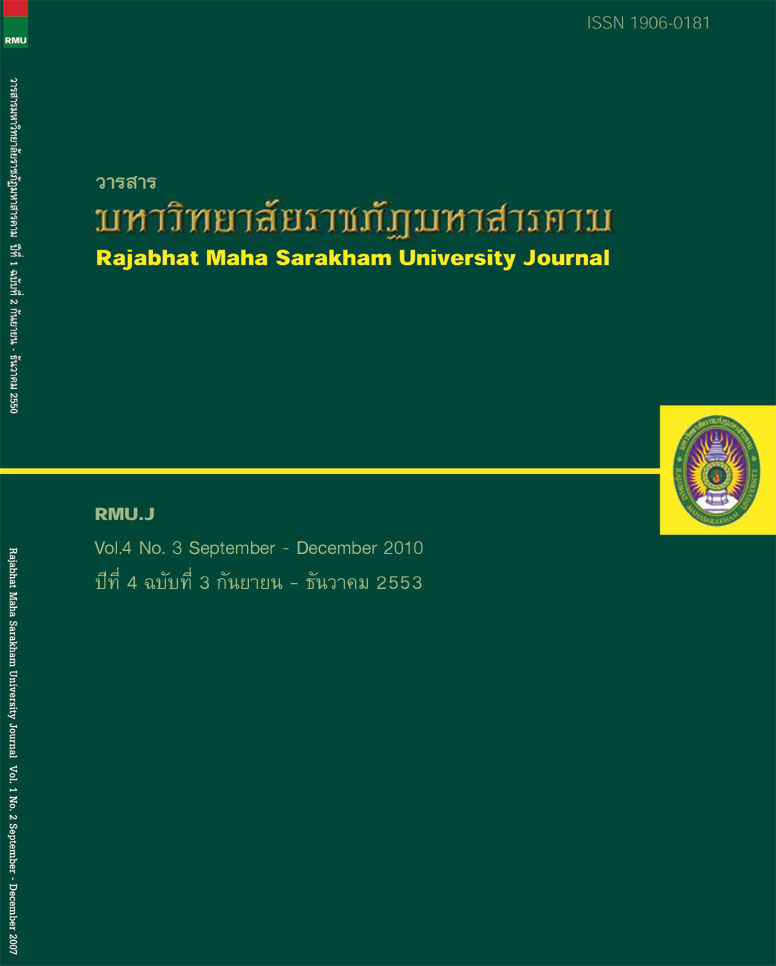การพัฒนารูปแบบการเรียนรู้ร่วมกันโดยใช้ปัญหาเป็นหลักที่มี การเสริมศักยภาพทางการเรียนผ่านเครือข่ายคอมพิวเตอร์ Collaborative Problem-Based Learning Development with Scaffolding via Computer Network
Main Article Content
บทคัดย่อ
การวิจัยครั้งนี้มีวัตถุประสงค์เพื่อ 1) สังเคราะห์รูปแบบการเรียนรู้ร่วมกันโดยใช้ปัญหาเป็นหลักผ่านเครือข่ายคอมพิวเตอร์ หรือ CPBL 2) พัฒนาบทเรียนคอมพิวเตอร์ตามรูปแบบ CPBL 3) หาประสิทธิภาพของบทเรียนคอมพิวเตอร์ตามรูปแบบ CPBL 4) เปรียบเทียบผลสัมฤทธิ์ทางการเรียนระหว่างกลุ่มผู้เรียนที่เรียนด้วยบทเรียนคอมพิวเตอร์ตามรูปแบบ CPBL กับกลุ่มผู้เรียนที่เรียนด้วยวิธีการสอนแบบปกติ และ 5) หาความพึงพอใจของผู้เรียนที่มีต่อบทเรียนคอมพิวเตอร์ตามรูปแบบ CPBL วิธีการดำเนินการวิจัย แบ่งเป็น 2 ขั้นตอน ได้แก่ ขั้นตอนการสังเคราะห์รูปแบบ CPBL ด้วยเทคนิคเดลฟาย และขั้นตอนการพัฒนาบทเรียนคอมพิวเตอร์ตามรูปแบบ CPBL ด้วยขั้นตอน ADDIE Model เครื่องมือที่ใช้ในการวิจัย ได้แก่ แบบสอบถาม แบบทดสอบ และบทเรียนคอมพิวเตอร์ กลุ่มตัวอย่างที่ใช้ในการวิจัย แบ่งเป็น 2 กลุ่ม ได้แก่ กลุ่มผู้เชี่ยวชาญ 4 กลุ่มย่อย
รวม 54 คน และกลุ่มนักศึกษาโปรแกรมวิชาวิทยาการคอมพิวเตอร์ มหาวิทยาลัยราชภัฏมหาสารคาม 2 กลุ่มย่อย จำนวน 52 คน ผลการวิจัยพบว่า
รูปแบบ CPBL มีองค์ประกอบ 2 ด้าน คือ ด้านโมดูลหลัก และด้านสภาพแวดล้อม สำหรับด้านโมดูลหลัก ประกอบด้วยโมดูล การเรียนรู้โดยใช้ปัญหาเป็นหลัก การเรียนรู้ร่วมกัน การช่วยเสริมศักยภาพการเรียน การประเมินผล ฐานความรู้ ผู้เรียน ผู้สอน และการติดต่อสื่อสาร และด้านสภาพแวดล้อม ประกอบด้วย กลไกการเรียนรู้โดยใช้ปัญหาเป็นหลัก กลไกการเรียนรู้ร่วมกัน กลไกการช่วยเสริมศักยภาพการเรียน บทบาทของผู้สอน บทบาทของผู้เรียน การประเมินผลการเรียน
ชุดการเรียนการสอน เครื่องมือสนับสนุน และการตรวจตราพฤติกรรมผู้เรียน ส่วนผลการพัฒนาบทเรียนคอมพิวเตอร์ตามรูปแบบ CPBL ได้บทเรียนที่มีประสิทธิภาพสูงกว่าเกณฑ์มาตรฐานของเมกุยแกนส์ ผู้เชี่ยวชาญมีความคิดเห็นต่อบทเรียนคอมพิวเตอร์ CPBL อยู่ในระดับเหมาะสมมาก ผู้เรียนกลุ่มทดลองที่เรียนด้วยบทเรียนคอมพิวเตอร์ที่พัฒนาขึ้นมีผลสัมฤทธิ์ทางการเรียนสูงกว่ากลุ่มควบคุมที่เรียนด้วยวิธีการสอนแบบปกติ และผู้เรียนมีความพึงพอใจต่อบทเรียนคอมพิวเตอร์ตามรูปแบบที่พัฒนาขึ้นอยู่ในระดับมาก
The objectives of this research were to 1) synthesize a model of Collaborative Problem-Based Learning via Computer Network (CPBL), 2) develop the CPBL computer instruction, 3) assess the efficiency of the computer instruction, 4) compare the achievement between the students who learned with the CPBL computer instruction and the students who had a regular class and 5) survey the satisfaction of students with the CPBL computer instruction. The research methodology consisted of two steps: the synthesis of CPBL step with Delphi technique and CPBL computer instruction development with ADDIE model. The research instrument consisted of questionnaire, quiz and computer instruction. The sample subjects were divided into two groups. The first group consisted of fifty four experts and divided into four sub-groups. The second group consisted of fifty two students and divided into two sub-groups.
The results of research indicated that the CPBL consisted of two components: a main module and an environmental component. The main module consisted of problem-based learning module, collaborative module, scaffolding module, assessment module, knowledge-based module, student module, coaching module and communication module. The environmental component consisted of mechanism of problem-based learning, mechanism of collaborative learning, mechanism of scaffolding, role of teacher, role of student, learning assessment, learning teaching package, tools-supported and monitoring of behavioral student. The results indicated that the value of the efficiency of the CPBL computer instruction was higher than the standard of Meguigans. The average opinion of the experts towards the CBPL computer instruction was high. The learning achievement of the students who studied with the CPBL computer instruction was significantly higher than those of studying in the regular class, and the average level of the satisfaction of the students with the CPBL computer instruction was high.
Article Details
1. บทความที่ลงตีพิมพ์ทุกเรื่องได้รับการตรวจทางวิชาการโดยผู้ประเมินอิสระ ผู้ทรงคุณวุฒิ (Peer Review) สาขาที่เกี่ยวข้อง อย่างน้อย 3 ท่าน ในรูปแบบ Double blind review
2. ข้อคิดเห็นใด ๆ ของบทความที่ลงตีพิมพ์ในวารสารมหาวิทยาลัยราชภัฏมหาสารคาม นี้เป็นของผู้เขียน คณะผู้จัดทำวารสารไม่จำเป็นต้องเห็นด้วย
3. กองบรรณาธิการวารสารมหาวิทยาลัยราชภัฏมหาสารคาม ไม่สงวนสิทธิ์การคัดลอกแต่ให้อ้างอิงแสดงที่มา


